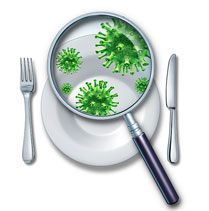
Learn these quick and easy tips for food safety to keep the whole family safe when preparing foods at home!
The Food and Drug Administration defines foodborne illness as a sickness that occurs when people eat or drink harmful microorganisms (such as bacteria, parasites, viruses) or chemical contaminants found in foods or drinking water. According to the Centers for Disease Control and Prevention, over 76 million people in the United States suffer from a foodborne illness each year, with the most susceptible being young children, older adults, pregnant women, and individuals with a compromised immune system.
You can help reduce the risk of contracting foodborne illness at home by taking a few simple precautions. Below is a list of helpful definitions, identifiers, and practical tips to make your kitchen safe and food friendly.
What are symptoms of foodborne illness?
It depends on which type of foodborne illness you’ve contracted, but common symptoms include (but are not limited to) nausea, vomiting, diarrhea, abdominal cramps, aches, dehydration, and fever.
How quickly will symptoms appear?
Again, it depends on the type of foodborne illness, but symptoms can appear in as little as 1 hour or up to a week or more. The best thing to do is to contact your health care provider if you suspect the onset of foodborne illness.
What causes foodborne illness?
Improper food handling:
- Raw food that has been contaminated via processing, storage, transportation, or preparation can be a carrier.
Incorrect cooking/reheating time:
Many times, the outer appearance of food doesn’t change, even when bacteria is multiplying within! The key to stopping growth is to fully cook or reheat the food. Refrigeration and freezing will slow, but not prevent, the growth of harmful bacteria.
Inappropriate holding times:
At home, it’s crucial to keep food out of the “danger zone” where bacteria multiply most rapidly. Bacteria grow best at temperatures above 40 ° F and below 140° F, so to keep you and your family safe, be sure to keep your refrigerator set to 40 ° F or lower and cook foods to 140° F or higher.
What are the preventative measures you can take to prevent foodborne illness at home?
Remember the 4 step method- Clean, Separate, Cook, Chill.
Clean:
- Don’t wash produce until right before it’s to be used.
- Wash everything that the raw food item comes into contact with
(hands, utensils, cutting boards, etc.) with hot water for at least 20 seconds. - Post-prep, sanitize counters and utensils with a bleach solution.
Separate:
- Keep food groups separate during prep- don’t place ready to eat food next to the raw ingredients.
- Use a different colored cutting board and utensils for each food group.
- Example: Red for meats, green for veggies, and white for fish
Cook:
- Invest in and use a food thermometer to make sure internal temperatures are out of the danger zone. These are the minimum temperatures that your meats should be cooked at:
145°F– Roasts, steaks, chops of beef, veal, and lamb
160°F– Pork, ground veal, ground beef
165°F– Ground poultry
180°F– Whole poultry- Also, remember to throw away foods that have set out at room temperature for over two hours.
Chill:
- Freeze or refrigerate leftovers immediately after consuming.
- Check the temperature of your refrigerator and freezer regularly.
- The refrigerator should be no warmer than 40° F, and the freezer should register 0° F.











